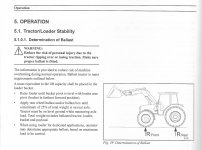In the few instances where I have used the FEL without a counterweight, it has caused more problems than benefits. Rear tires lose traction, end up ripping up sod, or on wet level grass, just spin, forcing use of 4WD. The extra weight on the front axle is also more likely to cause driveline damage with extensive use. The counterweight reduces the likely hood of this happening.
When things go wrong, it happens very quickly. Practices that reduce the chances of accident/injury should be encouraged. Tractor sluggish? run at a higher RPM. You are not doing the tractor any favors be operating at a low RPM.
The DIY cement blocks are great guides on low cost/customizable counterweights that add to the overall safe operation/reduced mechanical stress while increasing the functionality by being able to add storage/tool racks to the tractor.
